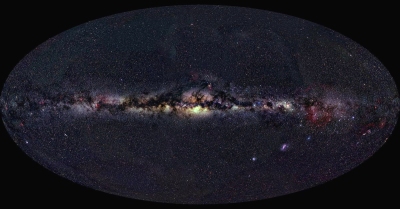Optical
| Wavelength range | m | 7×10-7 - 4×10-7 |
| Frequency range | Hz | 4×1014 - 8×1014 |
| Energy range | eV | 2 - 3 |
 |
|
Mosaic of optical images covering the whole sky. Copyright 2000 Axel Mellinger (taken from "All-sky Milky Way panorama" pages). |
ESA Missions
Hubble
The Hubble Space Telescope covers the energy range 0.1 to 2.5 µm, encompassing the entire optical part of the spectrum along with parts of both the ultraviolet and the infrared.
Hipparcos
Hipparcos was in orbit from 1989-1993 and was the first space mission dedicated to accurately measuring the positions of the stars. It helped to predict the impacts of Comet Shoemaker-Levy 9 on Jupiter and identified stars that will pass close to the Sun.
Gaia
The primary objective of the Gaia mission is to survey more than one billion stars in our Galaxy and beyond to create a three-dimensional map of the Milky Way, in the process revealing the composition, formation and evolution of our Galaxy. Data from this astronomical census will allow astronomers to answer some fundamental questions about the formation and evolution of our Galaxy, and will provide insight into many other topical areas of astronomy.
Sources of optical emission include
- Stars: the majority of all optical emission in the Universe comes from stars.
- Nebulae
- Interstellar gas: emission lines from metals (elements other than hydrogen and helium)
